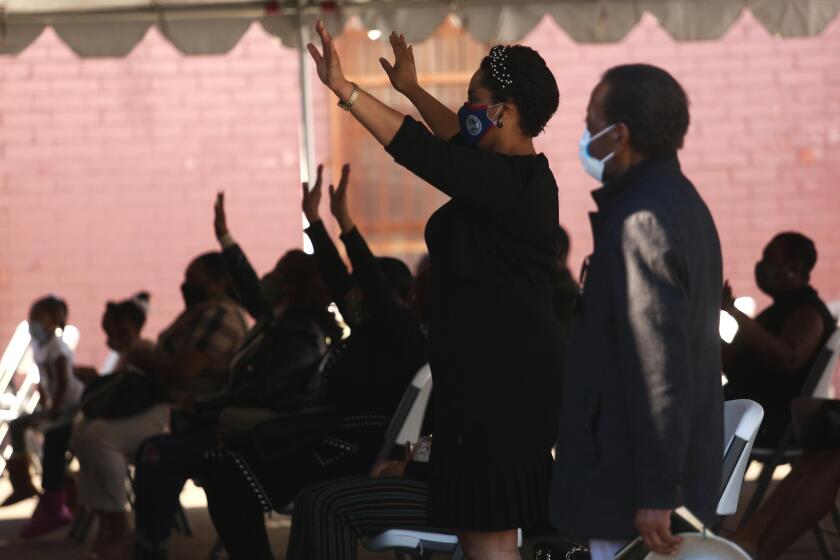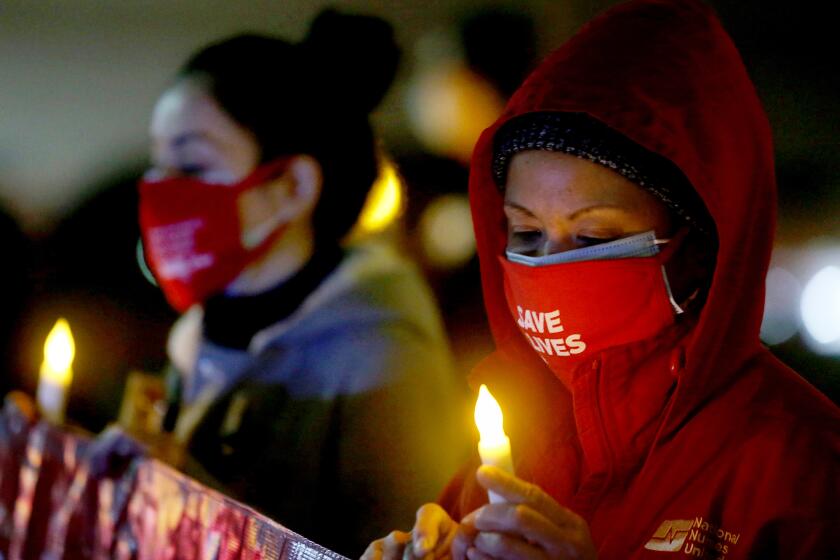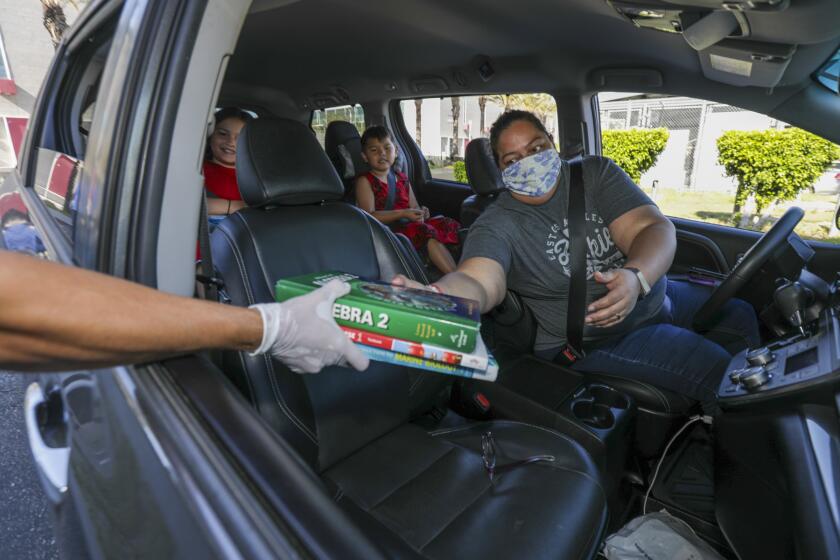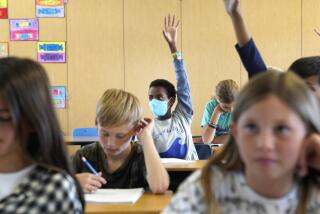L.A. County shatters daily coronavirus record as infections reach alarming levels
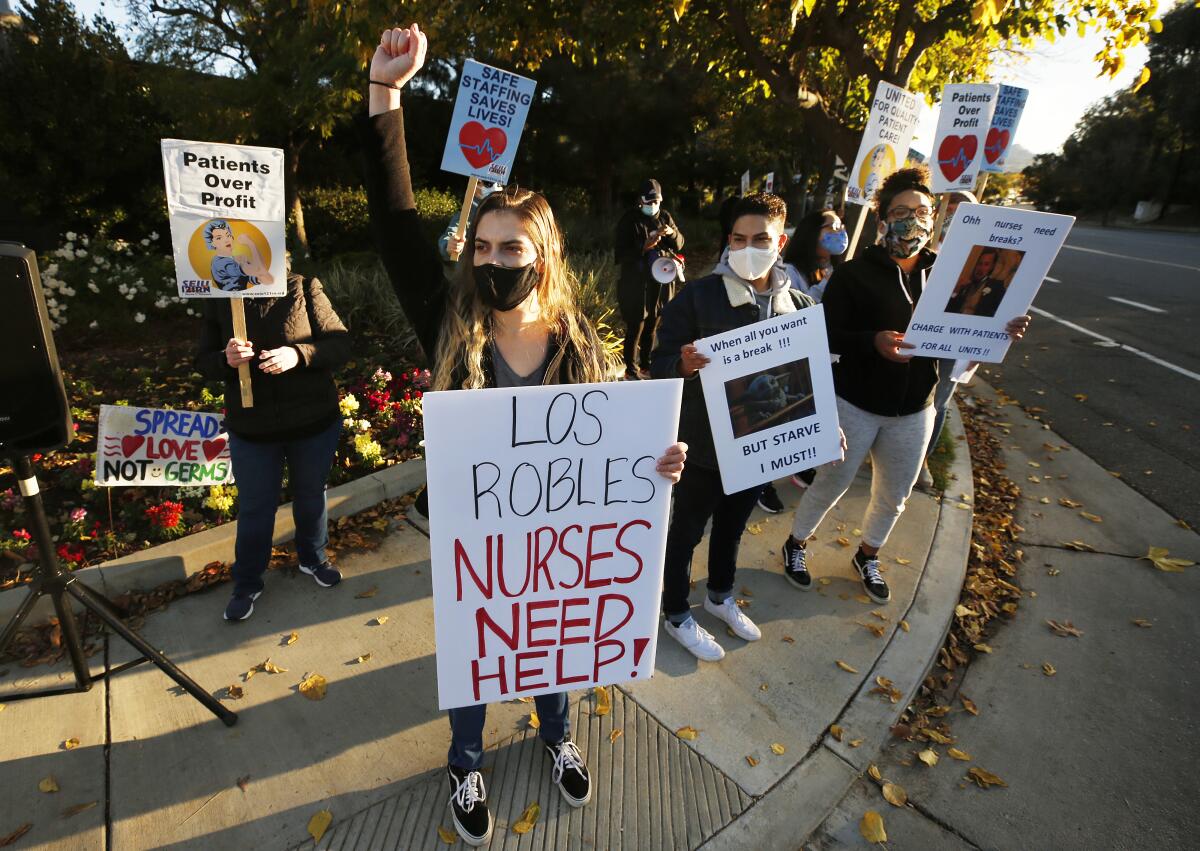
- Share via
Los Angeles County recorded a dramatic one-day rise in coronavirus cases Tuesday, shattering the single-day record and confirming some of the most dire forecasts about infections spreading ferociously as the holiday season gets underway.
The surge in cases renewed worries about how the healthcare system will handle a crush of new patients, with some hospitals already approaching capacity. The numbers put more pressure on state and local officials to enact a tougher stay-at-home order in hopes of slowing the spread. Officials feared the Thanksgiving holiday period would bring a flood of new cases, and there are growing concerns the spike is far from over.
L.A. County is now forecasting up to 8,000 new coronavirus cases a day by the end of this week and potentially 9,000 a day by the middle or end of next week, according to a source who listened to a briefing given by county health officials.
Gov. Gavin Newsom has announced a stay-at-home order affecting most of California.
‘The worst day thus far’
L.A. County on Tuesday reported more than 7,500 new cases — the most in a single day, which the director of public health called “the worst day thus far” of the pandemic. The previous single-day high for all of L.A. County was recorded on Nov. 23, according to The Times’ independent tally, with 6,186 cases.
“It will likely not remain the worst day of the pandemic in Los Angeles County. That will be tomorrow, and the next day and the next as cases, hospitalizations and deaths increase,” Public Health Director Barbara Ferrer said in a statement.
Coronavirus cases and hospitalizations have hit unprecedented levels in California, and officials expect conditions to deteriorate rapidly in the coming weeks.
With Tuesday’s tally of 7,532 cases, L.A. County is close to averaging 5,000 coronavirus cases a day over the last week — an astonishing quintupling of the figure from mid-October, when there were only about 1,000 cases a day. Even in the summertime surge, which had been the worst of the pandemic, L.A. County maxed out at about 3,300 cases a day.
Hospitalizations have more than tripled since Halloween, when there were about 800 people hospitalized, and surged past 2,400 on Monday. It was the second-consecutive day that the high for hospitalizations in L.A. County has been broken, and a number that’s 9% higher that the peak from the summer wave.
The unprecedented spread of infections in this third wave of the pandemic comes as local officials implemented some of the strictest coronavirus-related regulations the county has seen in months, and as state officials warn that even more drastic action, such as a version of a stay-at-home order implemented in the springtime, may be necessary before hospitals are overwhelmed with patients.
Public health officials in some counties are warning that unless the coronavirus surge can be stopped, hospitals could run out of beds in weeks.
ICUs may be beyond capacity by mid-December
Gov. Gavin Newsom on Monday said Southern California is forecast to run out of intensive care unit capacity by mid- to late December if current trends continued. By Christmas Eve, ICU beds are forecast to be at 107% of capacity across the region. While intensive care treatments have improved since the early days of the pandemic, all bets are off once ICUs are pushed beyond capacity.
“If, all of a sudden, you have one nurse taking care of seven patients on ventilators like in New York, the mortality can be astronomical,” said Dr. George Rutherford, an epidemiologist and infectious disease expert at UC San Francisco.
More alarming, the cases reported Tuesday don’t represent infections that occurred during Thanksgiving. Because of the virus’ incubation period of up to two weeks, transmission that occurred over the holiday will show up in confirmed lab tests by roughly mid-December. That influx could be accompanied by a jump in hospitalizations around Christmas and New Year’s Day, with a bump in deaths by mid-January.
Forty-six coronavirus-related deaths were reported in Los Angeles County on Tuesday. That’s significantly higher than the daily average of reported deaths over the last week, which has been about 30 a day.
In the face of the increases, county officials on Monday enacted a “targeted safer-at-home order” that is in effect through Dec. 20. It closes public playgrounds; places new capacity limits on retail stores, outdoor museums, galleries, zoos and aquariums; and prohibits all gatherings among people from different households, except for outdoor religious services and political demonstrations.
California has failed during the COVID-19 pandemic to provide a free and equal education for all California students, violating the state Constitution, according to a lawsuit.
Hospital beds filling faster than ever
The deteriorating situation seen in L.A. County is also playing out statewide, where more than 1.24 million people have been infected and more than 19,300 have died.
On Monday, statewide hospitalizations broke another record for the third consecutive day, with 8,240 people hospitalized with COVID-19. That’s 15% worse that the previous high in the summer, when hospitalizations topped out at 7,170.
The average net increase in people hospitalized in California with COVID-19 is now about 342 patients a day over the last week, according to a Times analysis. The acceleration is twice as bad as the summertime surge, which saw the average net increase in hospitalizations top out at 173 patients a day over a weeklong period in late June.
San Francisco officials signaled they may impose their own quarantine order for travelers and further reduce indoor capacity at businesses, similar to a new order issued by Santa Clara County on Monday, and would not rule out banning outdoor restaurant dining, a step L.A. County took last week.
“What we are seeing now is a spike unlike anything we have seen since the beginning of this pandemic,” San Francisco Mayor London Breed said. “We are in trouble, and we are sounding the alarm.”
‘Hospital bed shortage by Christmas’
San Francisco is in the middle of a major surge that threatens to overwhelm the healthcare system, and the daily coronavirus case rate is not expected to stabilize soon, warned its director of health, Dr. Grant Colfax. With many people ignoring calls to stay home over Thanksgiving, “we know, unfortunately, that the worst is likely yet to come,” Colfax said. “If this trend continues, we will see a hospital bed shortage around Christmas.”
The most recent statewide seven-day positivity rate was 6.5%, double what was recorded on election day, when the positivity rate was 3.2%. The daily positivity rate for L.A. County is worsening dramatically, with officials reporting a daily rate of nearly 12% on Tuesday, up from 7% a week earlier.
Policymakers and public health officials worry how the skyrocketing infection numbers will eventually affect California’s hospitals.
Providing ICU-level care usually entails “specialized space, specialized equipment and specialized staff” — meaning that, while hospitals can expand their capacities, their ability to do so is not infinite, according to Dr. Mark Ghaly, California’s health and human services secretary.
When intensive care unit staffing is stretched, Ghaly said, “we know that the quality of care ... sometimes takes a dip, and we see outcomes we don’t want to see” because resources are spread too thin.
L.A. County at ‘most difficult moment in the pandemic’ as hospitals fill up, cases soar
A more targeted ‘stay-at-home’ order?
As the surge in newly confirmed cases continues, officials are warning they may need to resort to drastic restrictions to change the state’s trajectory.
Those could include a new stay-at-home order for areas in the strictest, purple tier of California’s coronavirus reopening system, according to Newsom.
Specifics as to when such an order may be handed down, or what precise form it would take, remain scarce at this point — though Newsom pledged “we will be coming out with some additional information, some additional recommendations in the very, very near future.”
While the notion of a stay-at-home order brings to mind the rapid, widespread lockdown of businesses and public spaces seen during the early days of the pandemic, state officials said they are endeavoring to be more precise in their approach this time.
“One of the most important things we’ve learned is we can be not just more surgical with what we do, but we can really prescribe it for a shorter or a different amount of time,” Ghaly said. “Early on, some of those orders really were open-ended; we weren’t sure. Today, we know that we can get impact from certain interventions in a reliable way more quickly, and that’s part of what we’re considering.”
While many local officials and residents have pushed the state to be even more targeted — catering restrictions and enforcement efforts toward specific sectors or even individual businesses and facilities that data show are a source of spread — Ghaly said transmission of the coronavirus is so widespread that “everyone is somewhat vulnerable to having an encounter with somebody who’s infected.”
“Everybody wants us to identify the sector where spread is happening, and the truth is, when you have this level of community spread, it’s happening in our communities, first and foremost,” he said. “So the minute you walk in the door of any entity indoors, the chance of encountering someone with COVID who can actually transmit it is higher than it’s ever been.”
Hope for vaccine rises
Though the possibility of additional shutdowns may increase resentment levels among the public, officials emphasized that there is light at the end of the tunnel — including the potentially imminent arrival of a vaccine.
Newsom said California expects to receive about 327,000 doses of Pfizer’s COVID-19 vaccine within the next few weeks.
While it won’t be a silver bullet — as widespread rollout to the general public is likely months away — officials said the prospect of even a limited number of doses is still a silver lining.
“Our most vulnerable could be getting vaccinated, our front-line healthcare workers could be getting vaccinated in just a matter of weeks — opening the gateway to so many more receiving this important tool to protect us,” said Ghaly.
Times staff writers Maura Dolan, Sean Greene and Ryan Murphy contributed to this report.
More to Read
Sign up for Essential California
The most important California stories and recommendations in your inbox every morning.
You may occasionally receive promotional content from the Los Angeles Times.

